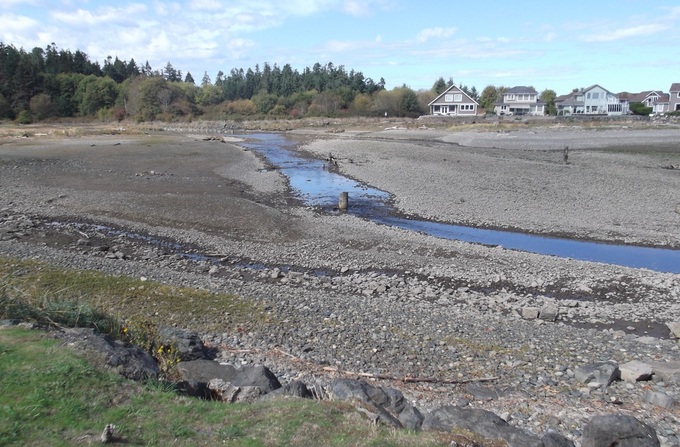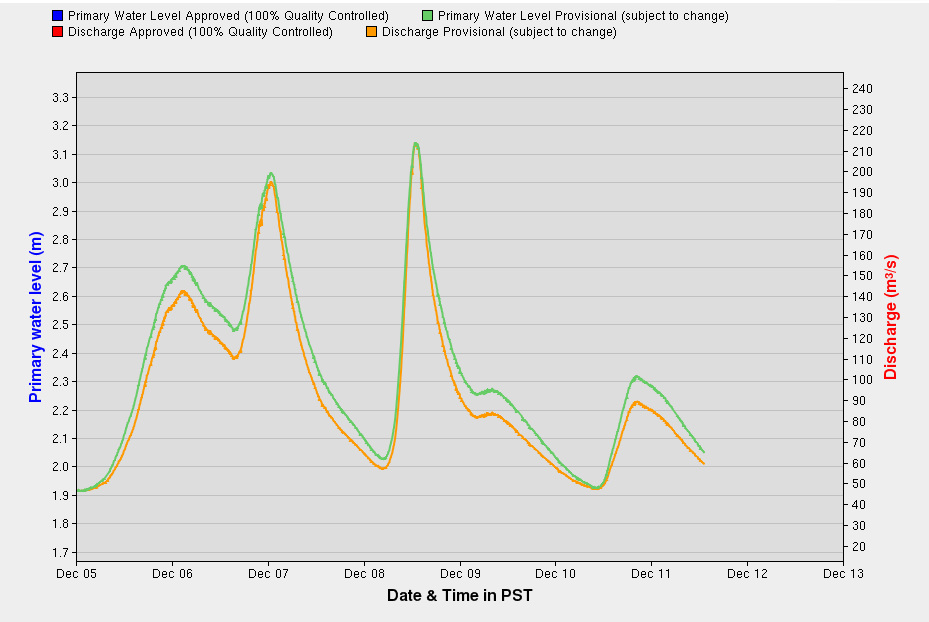Water Quantity
There is Enough Water to Sustain the Present Population's Needs
|
The annual precipitation that falls on 5 square kilometers of land in this area would be enough water to supply most of the domestic needs for the present population. The watersheds within the supply catchment area cover more than 600 square kilometers. With proper management there is enough water to meet the current demands.
No Need for Watering Restrictions in Parksville If the equivalent of one days surplus storm water from the Englishman River were diverted and stored high up in the watershed.
Here is the math: The graph below shows the flow in the Englishman River during the first few days of December 2015. The highest peak show about 210 cubic meters per second at the Orange Bridge in Parksville. With the lowest flow at about 50 cubic meters per second, it would be reasonable to estimate an average of: About 1 hundred cubic meters per second Or 360 thousand cubic meters per hour Which is 8.6 million cubic meters in one day, almost as much water as in Arrowsmith Lake Or more than 60 million cubic meters in one week. The new water treatment plant is supposed to filter and produce: Up to 16 thousand cubic meters of water per day. In the 4 months during the driest part of summer the plant will need to extract: About 2 million cubic meters of water directly from the river. |

To see a presentation that explains some of the options for a sustainable and cost efficient water supply,
click the drip
If the equivalent volume of one day's storm water were diverted and stored upstream, the City of Parksville could have an ample supply of clean water during the summer months. Gravity would eliminate the need for pumping, and the clean water would require very little treatment. There is no shortage of water in the area, only a shortage of common sense.

Please click the drip to link to a short graphic presentation.
|
High Water Levels
|
Destructive high river flows occur mostly during the months from November to March in this area, occasionally flash flooding can happen at other times. The extreme flooding events are often caused by a ‘rain on snow’ event in the mountains. When a warming trend combines with heavy rain on a deep snow-pack.
This phenomena is called a 'rain - on - snow' event and can cause extreme flash flooding. The steep terrain running from 1,600 meters on Mt Arrowsmith to the coast within 25 kilometers, can cause extreme surges, of storm-water. Rapid water level rise and flooding is one concern. Other hazards include massive log jams from washed out trees, deadfall, and wood floated down by the storm-water. The log jams could be made much worse by the hundreds of ‘cabled trees’ incorporated along river banks for fish habitat enhancement. |

A gauge located near the orange bridge on the Island Highway in town measures the Real-Time Hydrometric Data Graph for ENGLISHMAN RIVER NEAR PARKSVILLE (08HB002) [BC. The graph will show the river level, (depth) and the flow rate in cubic meters per second (cu/meters/sec). The highest rate discharge in recent years is about 450 cu/meters/sec. And this summer the lowest flow was just over 0.7 cu/meters/sec. The preferred minimum flow for fish is considered 1.6 cu/meters/sec. Click the link below to show the Englishman River flow rate https://wateroffice.ec.gc.ca/report/real_time_e.html?stn=08HB002 |

This graph can show more than one parameter, check the options on the web page.
|

Low summer flows in rivers and creeks are harmful to fish and other aquatic creatures. The human impacts of land modification, drainage, hard surfacing, and the over extraction of ground-water is causing a regional change in climate. This impact is compounding the overall effects of climate change.
The picture is of the estuary from Morningstar and French Creek where they combine near the Marina. Morningstar Creek in the foreground is dry, French Creek is just a trickle.
The picture is of the estuary from Morningstar and French Creek where they combine near the Marina. Morningstar Creek in the foreground is dry, French Creek is just a trickle.
How are groundwater levels in the area?
British Columbia Groundwater Observation Well Network can show the general groundwater trends in this area.
There are 20 relevant wells that are updated on a regular basis.
If you click the link below, the fist page on the top line Select an observation well from the list
There are 20 relevant wells that are updated on a regular basis.
If you click the link below, the fist page on the top line Select an observation well from the list

Well #287 COOMBS (BURGOYNE ROAD)
Well #303 QUALICUM BEACH (YAMBURY RD.)
Well #304 PARKSVILLE (DESPARD RD)
Well #310 BOWSER ( GAINSBURG RD.)
Well #314 PARKSVILLE (SPRINGHILL RD.)
Well #321 QUALICUM (LEEWARD WAY)
Well #389 QUALICUM BEACH (W. ISLAND HWY)
Well #391 LITTLE QUALICUM (MEADOWOOD WAY)
Well #392 NANOOSE (DAWSON RD DEEP)
Well #393 NANOOSE (DAWSON RD SHALLOW)
Well #394 NANOOSE (NUTTAL DR.)
Well #395 NANOOSE (RIVER'S EDGE DR.
Well #396 NANOOSE (BALLENAS RD.)
Well #397 NANOOSE (NORTHWEST BAY RD.)
Well #398 PARKSVILLE (TRILL ROAD)
Well #425 QUALICUM (SPIDER LAKE RD. DEEP)
Well #426 QUALICUM (SPIDER LAKE RD. SHALLOW)
Well #427 QUALICUM (COCHRANE RD. SHALLOW)
Well #433 QUALICUM (GARDEN RD. E. DEEP)
Well #434 QUALICUM (GARDEN RD. E. SHALLOW)
Well #303 QUALICUM BEACH (YAMBURY RD.)
Well #304 PARKSVILLE (DESPARD RD)
Well #310 BOWSER ( GAINSBURG RD.)
Well #314 PARKSVILLE (SPRINGHILL RD.)
Well #321 QUALICUM (LEEWARD WAY)
Well #389 QUALICUM BEACH (W. ISLAND HWY)
Well #391 LITTLE QUALICUM (MEADOWOOD WAY)
Well #392 NANOOSE (DAWSON RD DEEP)
Well #393 NANOOSE (DAWSON RD SHALLOW)
Well #394 NANOOSE (NUTTAL DR.)
Well #395 NANOOSE (RIVER'S EDGE DR.
Well #396 NANOOSE (BALLENAS RD.)
Well #397 NANOOSE (NORTHWEST BAY RD.)
Well #398 PARKSVILLE (TRILL ROAD)
Well #425 QUALICUM (SPIDER LAKE RD. DEEP)
Well #426 QUALICUM (SPIDER LAKE RD. SHALLOW)
Well #427 QUALICUM (COCHRANE RD. SHALLOW)
Well #433 QUALICUM (GARDEN RD. E. DEEP)
Well #434 QUALICUM (GARDEN RD. E. SHALLOW)

